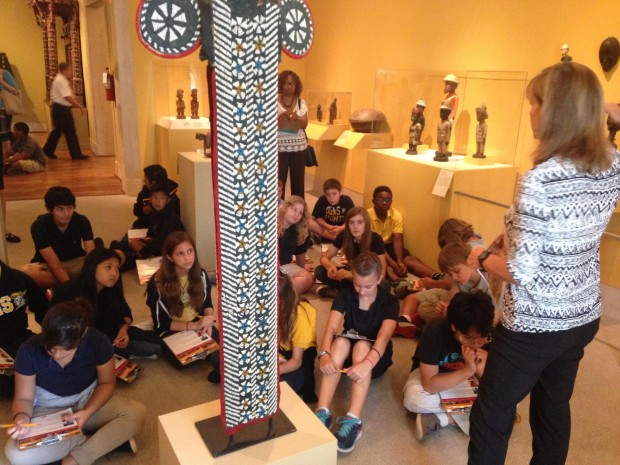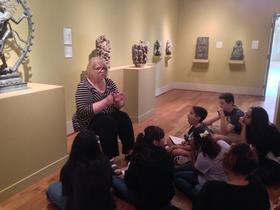Fine Arts Museum Bringing Students, Ancient Worlds Together

Mary Shedden / StateImpact Florida
St. Petersburg Museium of Fine Arts docent Tina Douglass shares the story behind an African elephant mask with sixth graders from Clearwater's Oak Grove Middle School.
It’s just a few dozen yards from the charter buses to the stately columns of the St. Petersburg Museum of Fine Arts entrance.
Dozens of energetic 12- and 13-year-olds jump off the bus after a 25-minute ride from their Clearwater’s Oak Grove Middle School.
Volunteer docents scramble to sort out small groups by color, and hand out clipboards and pencils.
“Purple, nice straight line!” one docent yells from the top of the steps.
“Green group over here,” another barks.
“Guys heads up,” says another volunteer at the front door. “Do you have gum? You need to put it in the garbage can when we go in.”
A few steps into the air-conditioned galleries and the Oak Grove Middle School student voices shift to whispers.
The groups spread out across the museum. History lessons about African ritual masks, ancient pottery, and a 19th Century bronze statue of a Hindu God commence.

Mary Shedden / StateImpact Florida
Oak Grove Middle School students arrive at the St. Petersburg Museum of Fine Arts for a tour of ancient civilizations and art.
Field trips like this one are a big a strain on stretched school budgets.
And a study by the American Association of School Administrators in 2010 found that leaders worried that time away from the classroom meant time lost preparing for standardized tests.
That year, 30 percent of administrators said they were eliminating some field trips.
Still, the St. Petersburg Museum of Fine Arts two years ago created a program that turns its galleries into an up-close history lesson.
It invited every single Pinellas County public school sixth graders to come visit what to most is an unfamiliar, cultured world.
And it doesn’t charge the schools – or the students – a dime.
Almost 6,000 Pinellas County world history students made the trip this year, said Anna Glenn, the museum’s director of public programs.
Students spend about two hours trying to connect the artwork in front of them to characteristics of a civilization, such as religion, social structure or government.
“It’s an opportunity then for the museum to become this learning lab for them,” said said. “If we think about the times we were in our science classes and we had to walk through labs and identify and sort of site those evidences for what we were learning. That’s what the museum is transformed into during these field trips.”
The field trip is a literal world tour, from Asia to Africa to all of the Americas. And the visitors respond only as middle schoolers would. Nude statues and paintings elicit giggles. A docent explaining how a gold cup was used for a drinking ritual involving spit grosses out some — but not all — of the students.

Mary Shedden / StateImpact Florida
Pinellas County world history students who tour the St. Petersburg Museum of Fine Arts are asked to connect artwork they see to the different characteristics that make up a civilization.
The day before the field trip, world history teacher Shelley Foster refreshed students about some ancient artwork back in the classroom in Clearwater. She discovers about half the students have never been to a museum before. Many of those have only been to kid-friendly venues, such as Tampa’s Museum of Science and Industry.
After watching a short video on museum etiquette, Foster placed a flashcard of musical instrument and other artifacts on the overhead projector.
“Raise your hand only, please don’t call out. Pease tell me any characteristics that you can link this lyre too,” she asks.
The characteristics mentioned in class and on the museum field trip have been central to how students have unfolded ancient civilizations all year long, Foster said. The field trip isn’t entertainment, it’s truly educational, she said.
“There is in almost every chapter depending on where we are a section where they talk about the art and the architecture and sometimes about engineering, the kinds of homes people lived in, and I think all of that would fall into that area,” she said.
At the museum the next day, Oak Grove student Skyler Overton stood with her classmates in front of a modern mixed media piece called “Dancing in the Street Pave in Gold,” by Tallahassee artist Mary Proctor. Her docent takes the history lesson another step.
Tina Douglass tells them the eclectic collage reflects religious and artistic aspects of our modern civilization.
“The seven characteristics of a civilization apply to ancient Greek and roman art, Japanese art, Chinese art, Hindu art, it also applies to art today,” she said.
Overton says she likes that the field trip didn’t dwell on ancient history, though she did like some of the Chinese earthenware from the time of the Han Dynasty.
“It’s kind of different to see how like one thing you see is 4,000 years old and the next thing you see something that was made 50 years ago – not even,” she said. “It’s kind of different, but it’s cool to see how things have evolved from old to new in a matter of time.
Glenn said transportation for the field trips is paid for by a voter approved property tax that supports art and technology in Pinellas County Schools. A corporate grant covers the museum’s expenses.
Students also receive a pass to return to the museum with their family, Glenn said. It’s a way to boost interest in the arts among youth, who account for about 15 percent of the St. Petersburg museum visitors today.

Mary Shedden / StateImpact Florida
A volunteer docent at the St. Petersburg Museum of Fine Arts explains a 19th century Indian statue of the Hindu God, Shiva as the King of Dance.
Overton said she isn’t so optimistic. While she already wants to bring her mom back for a museum tour, her middle school colleagues may not rush back.
“I think most of them were bored. Mostly the boys,” she said. “But it was very interesting and educational so I guess it’s a good field trip to go to.”
Or as someone said as the group headed out the museum doors, a day at an art museum is a lot more fun than being back at school.